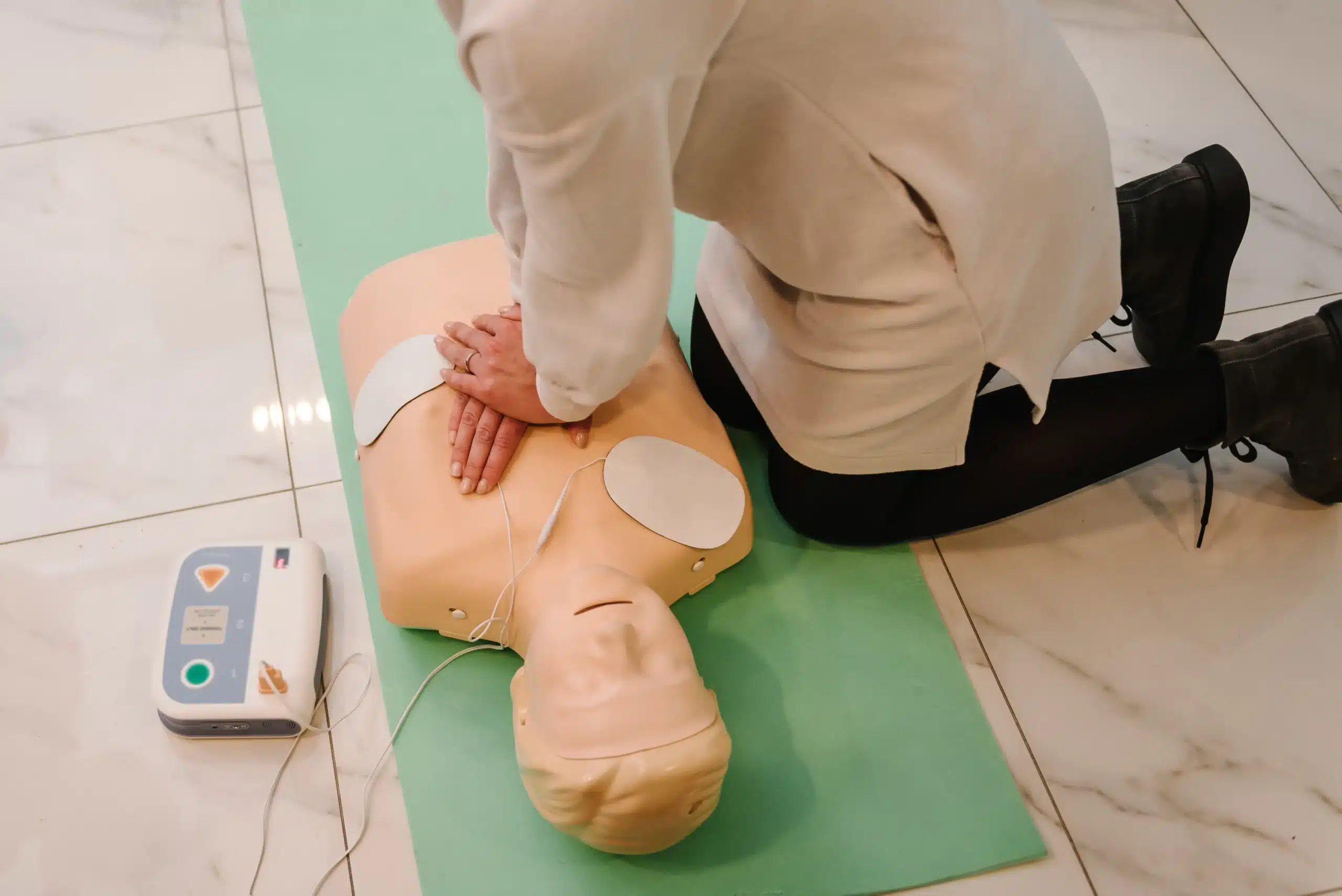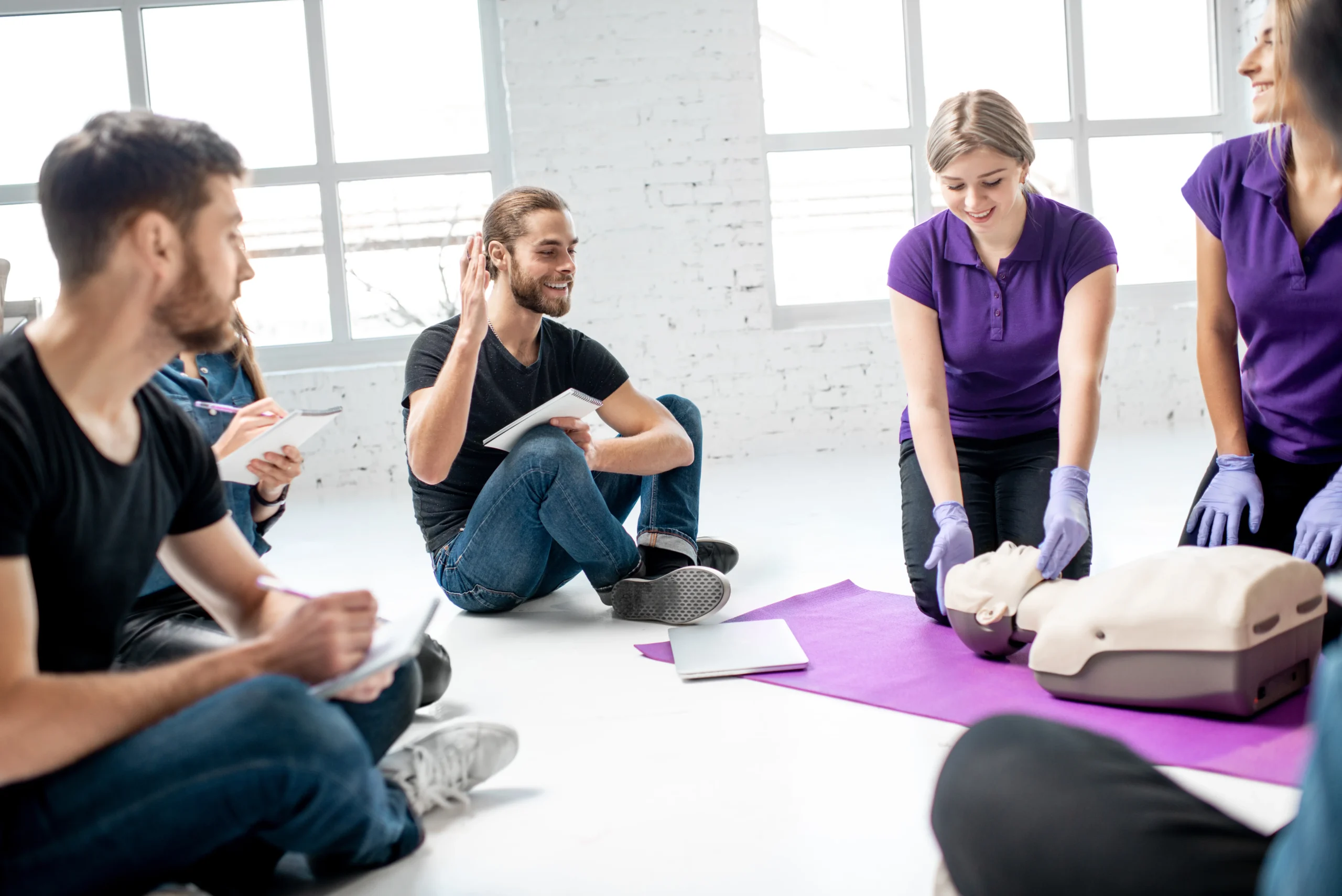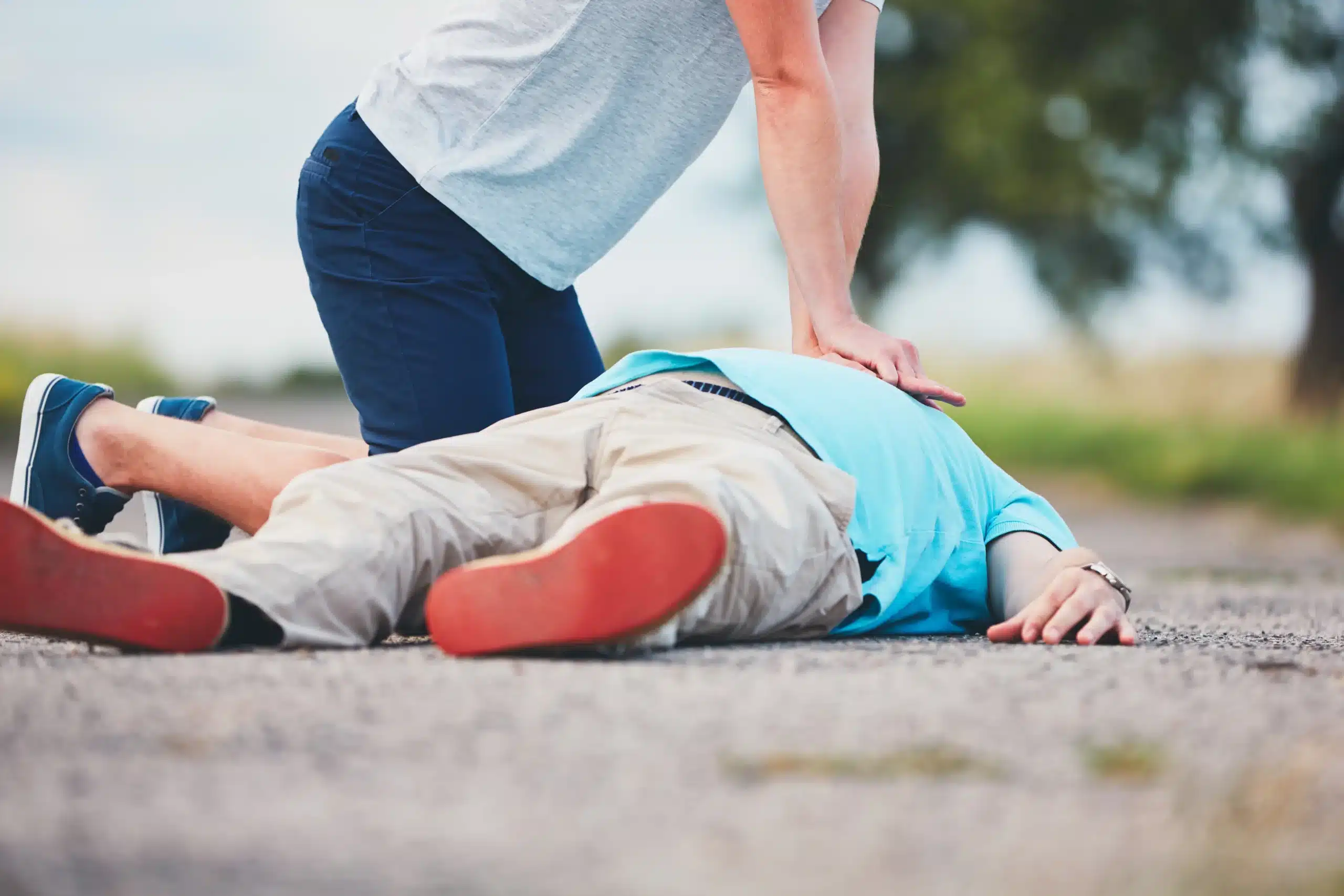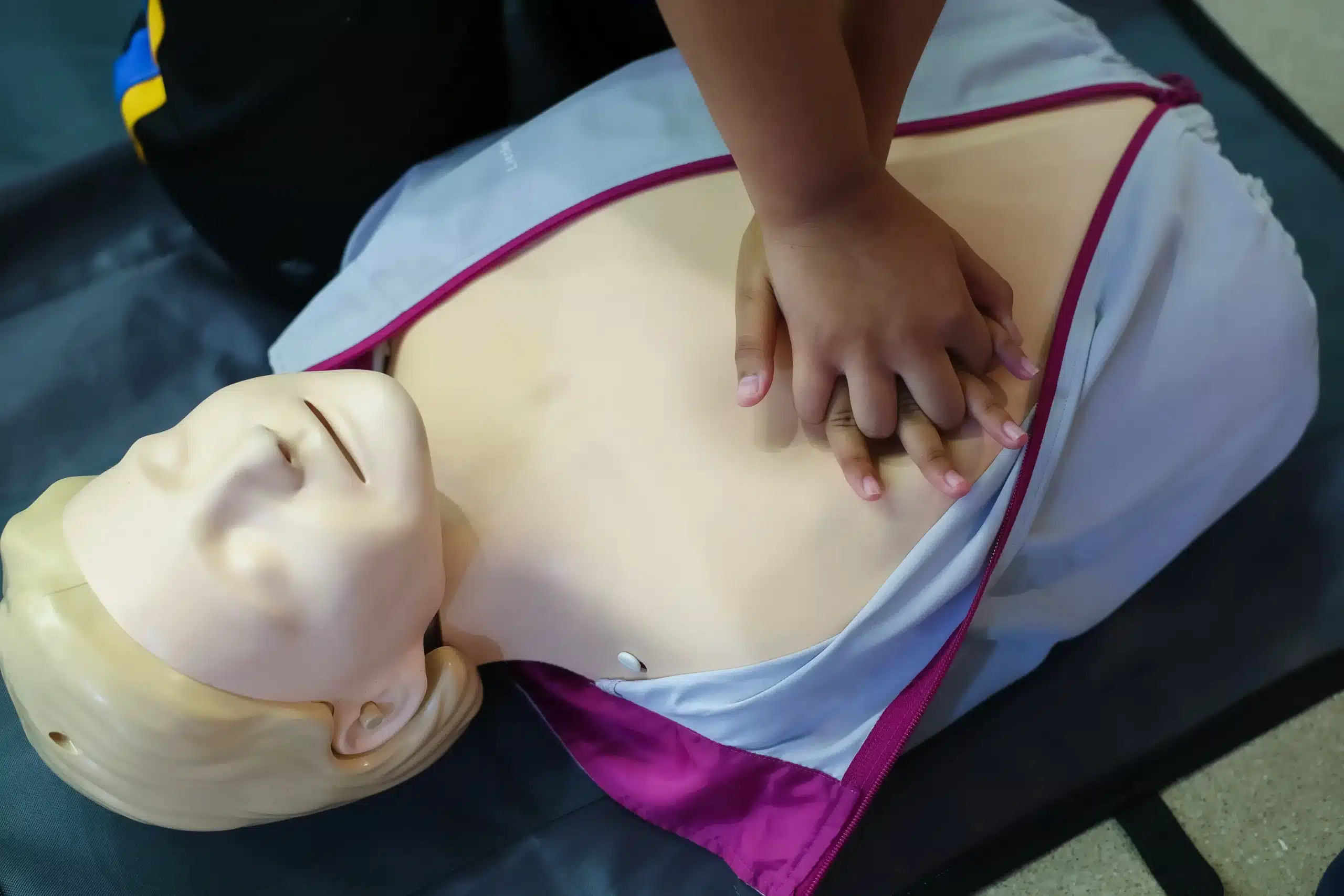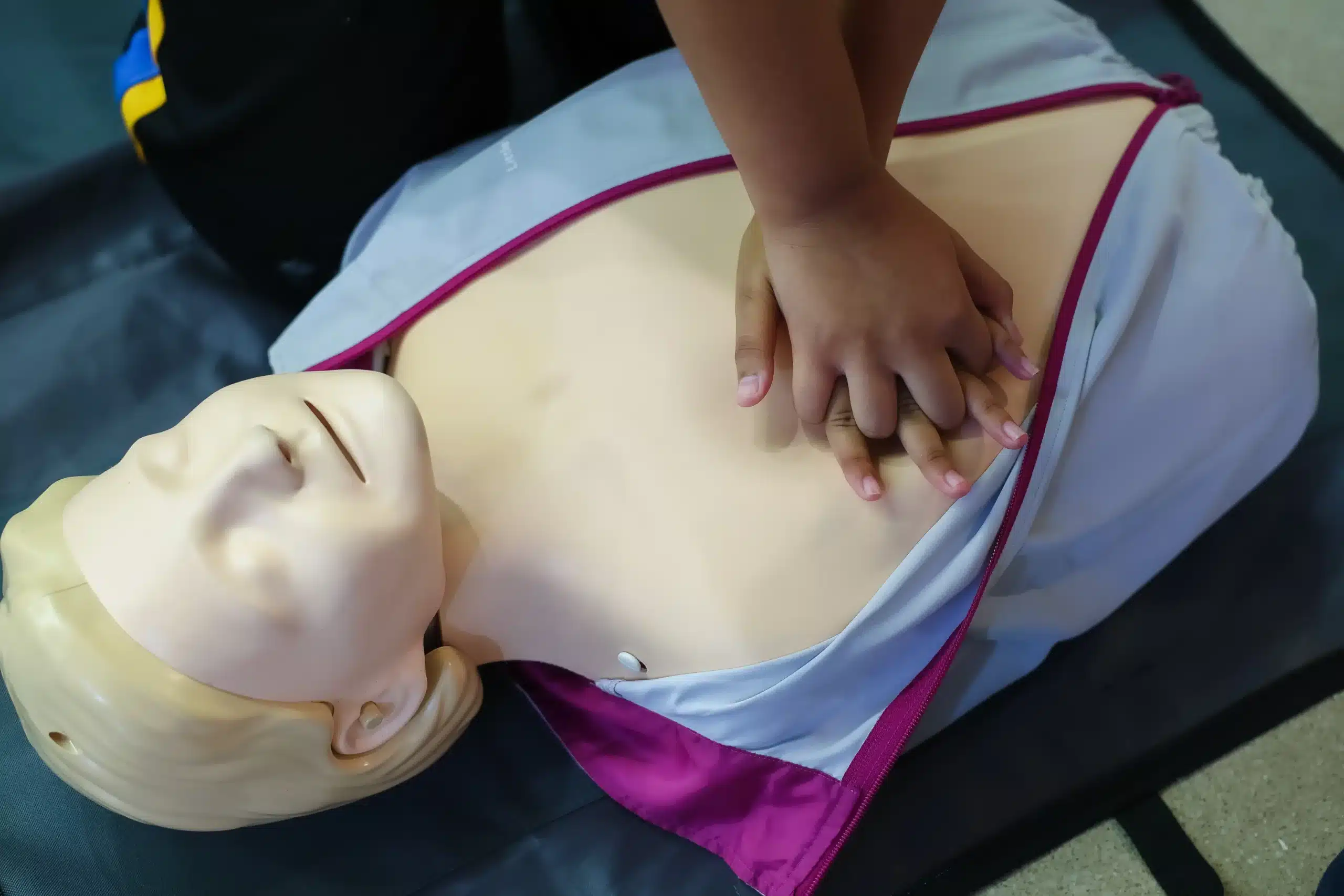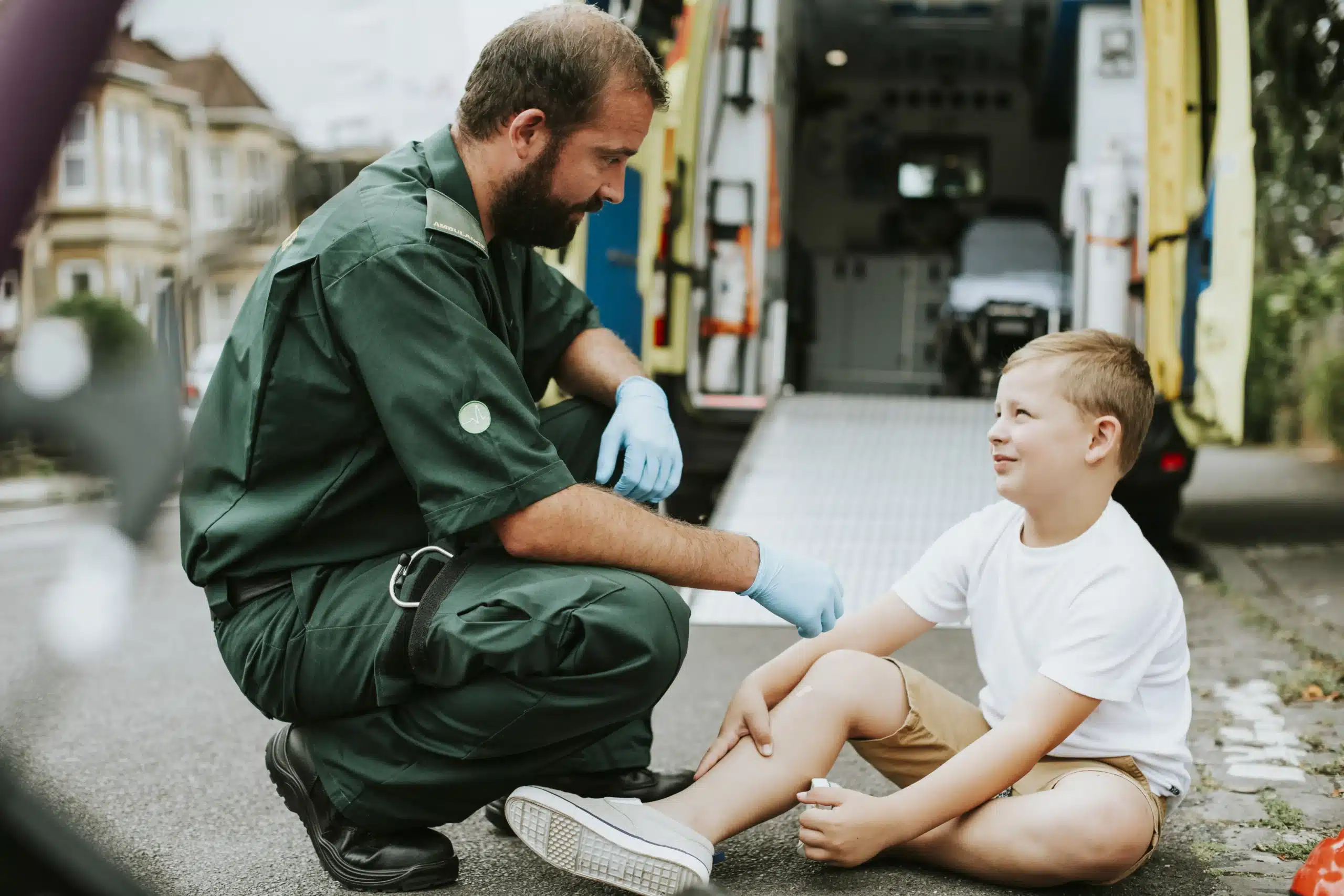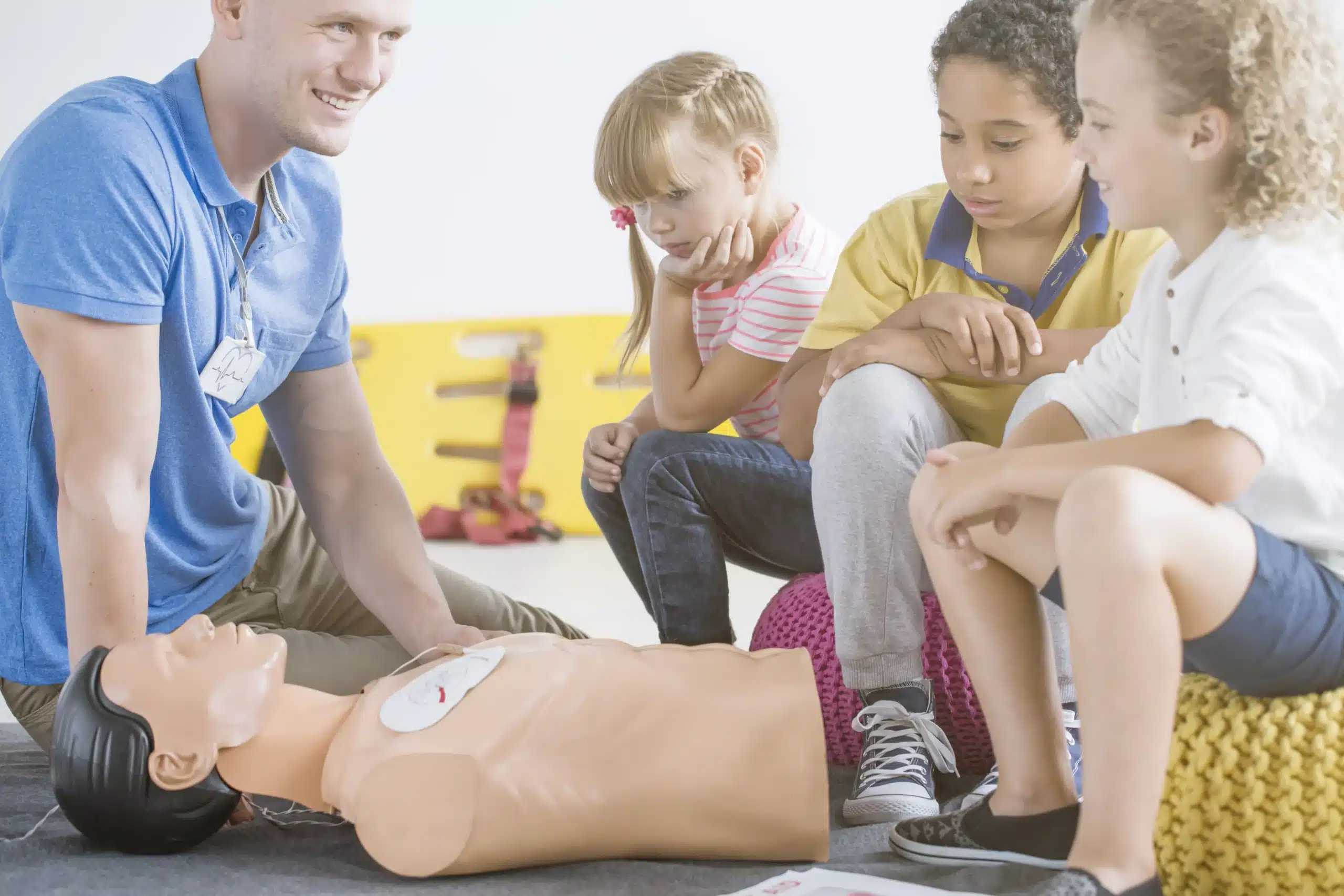Faced with a medical emergency, knowing CPR can transform you from a bystander into a lifesaver. But with so much information out there, finding the right CPR training can feel overwhelming. This guide simplifies the process, answering your questions about CPR training and certification. We’ll explore different types of CPR courses, including BLS, ACLS, and PALS, and discuss what each entails. We’ll also address common misconceptions about CPR and provide practical tips for finding “CPR courses near me.” Plus, we’ll delve into how to choose a reputable training provider and what to expect during your CPR class. Whether you’re in Petaluma, Rohnert Park, Novato, or beyond, this guide will empower you to find the perfect CPR training to suit your needs and schedule.
Key Takeaways
- CPR is easier to learn than you think: Debunk the myths and find a course near you—even basic CPR knowledge can make a difference. Look for options like combination First Aid and CPR training to be prepared for various emergencies.
- Find a reputable CPR course that fits your lifestyle: Consider in-person, online, or blended learning formats based on your schedule and learning preferences. Check for accredited providers, instructor experience, and hands-on practice opportunities.
- Stay current with your CPR skills: Regularly practice and take refresher courses to maintain your confidence and ensure you’re using the most effective techniques. Consider community involvement to reinforce your skills and empower others.
What is CPR and Why Does it Matter?
CPR, or Cardiopulmonary Resuscitation, is a lifesaving technique used when someone’s heart stops beating. It combines chest compressions and rescue breaths to circulate oxygenated blood to the brain and other vital organs. Learning CPR empowers you to respond effectively during cardiac arrest, a leading cause of death. CPR can double or even triple a person’s chance of survival. Bystander CPR can bridge the critical gap before professional medical help arrives, significantly increasing the likelihood of a positive outcome.
CPR Training Myths Debunked
Despite the importance of CPR training, several myths can discourage people from learning this essential skill. Let’s clear up some common misconceptions:
- Myth: CPR is Difficult to Learn: CPR isn’t as complicated as you might think. Anyone can learn it, and quality CPR training makes it easy to grasp the core techniques. Even basic CPR knowledge combined with the willingness to act can dramatically improve someone’s chances of survival. Safety Training Seminars offers various CPR courses to get you started.
- Myth: Mouth-to-Mouth Resuscitation is Always Necessary: Current American Heart Association (AHA) guidelines often prioritize compression-only CPR, especially for untrained bystanders. Mouth-to-mouth is necessary in specific situations, but the emphasis on compressions makes it less daunting for those hesitant about performing CPR. Learn more about these guidelines through our AHA-certified BLS course.
- Myth: CPR is Only for Adults: CPR is a vital skill for helping people of all ages. Whether it’s an adult, child, or infant, CPR is crucial if their heart stops beating. Age-specific training, like our PALS course, teaches you how to adapt the technique for different age groups.
- Myth: People are Afraid of Causing Injury: It’s natural to worry about doing something wrong, but the potential to save a life far outweighs the risk of causing minor injury. In most cases, people in cardiac arrest would much rather receive CPR than no help at all.
- Myth: Online Training is Just as Effective as In-Person Training: While online resources offer valuable information, they can’t replace the hands-on practice you get with in-person CPR training. Practical experience and feedback from a certified instructor are essential for developing the confidence and skills to perform CPR effectively. Consider our discount group classes for a valuable in-person learning experience.
CPR Courses Near You
Finding the right CPR course is the first step to becoming a confident lifesaver. Whether you’re a healthcare professional, a concerned parent, or simply someone who wants to be prepared for emergencies, understanding the different types of CPR courses available can help you choose the best fit. We offer a variety of American Heart Association certification courses in Petaluma, including BLS, ACLS, PALS, CPR, and First-Aid. Our Petaluma location conveniently serves Petaluma, Rohnert Park, and Novato, CA. Check out our low price guarantee.
Basic Life Support (BLS)
BLS certification is the foundation of CPR training. It covers essential skills needed to respond to life-threatening emergencies, including recognizing when CPR is necessary, performing high-quality chest compressions, and using an automated external defibrillator (AED). Our BLS certification course provides healthcare providers and other professionals with the knowledge and skills to respond to adult, child, and infant cardiac arrest emergencies.
First Aid and CPR
Combining First Aid and CPR training equips you with a comprehensive skill set to handle a broader range of emergencies. From treating minor injuries like cuts and burns to responding to serious cardiac events, this combined training empowers you to provide immediate care. We offer group discounts, making it even more accessible to train with friends, family, or colleagues.
Advanced Cardiac Life Support (ACLS)
ACLS certification is designed for healthcare professionals who manage cardiac arrest and other cardiovascular emergencies. This advanced training delves into more complex algorithms and interventions, including airway management, intravenous drug administration, and team dynamics during resuscitation.
Pediatric Advanced Life Support (PALS)
PALS certification focuses on the specific needs of infants and children facing respiratory or cardiovascular emergencies. It provides healthcare providers with the specialized knowledge and skills to assess, intervene, and stabilize pediatric patients in critical situations. Our PALS course covers essential topics such as pediatric assessment, airway management, and effective resuscitation techniques tailored to young patients.
Find Reputable CPR Training
Finding the right CPR training program is crucial for learning effective lifesaving skills. Here’s how to find reputable CPR classes near you:
Accredited Organizations
Start your search by looking for training providers accredited by nationally recognized organizations. The American Heart Association (AHA) and the American Red Cross are two leading providers of CPR certification courses. These organizations set high standards for training and certification, ensuring a quality learning experience. Other reputable organizations, like the National Safety Council (NSC), also offer CPR training. Choosing an accredited provider ensures your certification will be widely accepted.
Local Healthcare Institutions
Many hospitals and healthcare systems offer CPR training to both their staff and the public. Check with hospitals in your area, like Petaluma Valley Hospital or Kaiser Permanente, to see if they have CPR classes. These courses are often taught by experienced medical professionals and provide high-quality, hands-on training. Contacting your local healthcare providers is a smart way to find convenient and reputable CPR training.
Community Centers and Fire Departments
Local community centers and fire departments frequently host CPR training sessions. These classes are often more affordable and accessible to the community. Check with your city’s Parks and Recreation department or your local fire station for upcoming CPR training opportunities. These community-based programs are a valuable resource for learning essential lifesaving skills. For residents of Petaluma, Rohnert Park, and Novato, many community resources are available.
Search Online
A quick online search can help you find CPR training providers in your area. Use search terms like “CPR classes near me” or “AHA CPR certification [your city]” to find local options. Websites like Safety Training Seminars offer comprehensive CPR courses in over 60 cities, including Petaluma. When searching online, look for providers with positive reviews and clear information about their certification programs. Make sure the provider offers the specific type of CPR training you need, such as BLS, ACLS, or PALS.
Choose the Right CPR Course
Picking the right CPR course is a big deal. It’s about more than just getting a certificate—it’s about feeling confident you can act in an emergency. Here’s what to consider:
Course Content and Curriculum
First things first, check that the course aligns with nationally recognized guidelines. Look for courses based on standards from organizations like the American Heart Association (AHA) or the American Red Cross. This ensures you’re learning the most up-to-date and effective techniques. A good course will cover adult, child, and infant CPR, how to use an AED, and what to do if someone is choking. Our BLS course covers all of these essential skills.
Instructor Qualifications
Experienced, certified instructors make a huge difference. They can offer personalized feedback and create a comfortable learning environment. Don’t hesitate to ask about an instructor’s background and experience before signing up for a class. A knowledgeable instructor can answer your questions and adapt their teaching style to suit different learners. At Safety Training Seminars, our instructors are highly qualified and experienced healthcare professionals.
Class Size and Hands-on Practice
CPR is a hands-on skill. Look for smaller class sizes that allow for plenty of individual practice. The more you can practice on mannequins and with AED trainers, the more prepared you’ll feel in a real emergency. Simulations and realistic scenarios can also boost your confidence and problem-solving abilities. We keep our class sizes small to maximize hands-on learning.
Certification Requirements
Before you commit to a course, understand the certification and recertification process. How long is the certification valid? What will you need to do to renew it? Some organizations offer digital credentials, which can be convenient for tracking and verifying your qualifications. Knowing these details upfront will save you time and hassle down the road. Check out our FAQ for more information on our certification process. Our CPR courses meet American Heart Association requirements and offer certification upon completion.
CPR Course Formats and Length
Choosing the right CPR course format depends on your learning style, schedule, and employer requirements. Let’s break down the most common options: in-person, online, and blended learning.
In-Person Training
In-person CPR training emphasizes hands-on learning, crucial for mastering CPR techniques. You’ll practice on mannequins and receive real-time feedback from certified instructors. This format offers a structured learning environment and the opportunity to ask questions and interact with other students. Many employers prefer in-person training, sometimes even requiring it, to ensure a certain level of proficiency. If you learn best in a traditional classroom setting and value direct interaction, in-person training might be the right fit. Safety Training Seminars offers in-person classes in over 60 cities, making it easy to find a convenient location.
Online Courses
Online CPR certifications offer flexibility for busy schedules. Reputable organizations like the American Heart Association (AHA) and the American Red Cross (ARC) offer online courses that cover essential CPR knowledge. These courses can be a convenient way to learn the basics at your own pace. However, keep in mind that online-only courses may not meet all workplace requirements. Always check with your employer to ensure any online certification aligns with their guidelines. For example, some employers mandate in-person skills sessions.
Blended Learning
Blended learning combines the best of both worlds. You’ll complete online coursework at your own pace and then attend an in-person session for a hands-on skills assessment. This format offers flexibility while still providing the crucial hands-on practice needed to develop confidence and competence in performing CPR. Blended learning is a great option if you appreciate a flexible schedule but also recognize the value of in-person guidance and feedback. It allows you to absorb the information online and then demonstrate your skills in a real-world setting. The Red Cross offers blended learning CPR courses.
CPR Course Costs
CPR training is an investment in lifesaving skills, and understanding the associated costs can help you plan for your training. Several factors influence the price, including the type of course, location, and any special promotions. Knowing the typical price ranges can help you budget effectively.
Average Price Range
Standard CPR classes typically cost between $20 and $55 per person. Pediatric CPR training usually falls within the $25 to $40 range. Combined CPR and First Aid certification often costs somewhere between $40 and $60. For healthcare providers seeking Basic Life Support (BLS certification), the cost is generally around $60 to $80. Remember that these are average ranges, and prices can vary based on your location and the specific training center.
Group Rates and Promotions
Many training centers offer discounts for group bookings, making it more cost-effective to train your team or organization. Check with your chosen provider, like Safety Training Seminars, about group discounts and special rates for multiple participants. This can be a smart way to equip your workplace with essential lifesaving skills.
Low Price Guarantees
Look for training providers that offer a low price guarantee. This shows their commitment to providing affordable, high-quality training. Safety Training Seminars offers this guarantee, giving you confidence that you’re receiving excellent training at a fair price. Knowing you’re getting a good deal can make the process of choosing a CPR course less stressful.
CPR Certification and Renewal
CPR certification is a valuable asset, showing you’re ready to help in medical emergencies. But like many certifications, it has an expiration date. Staying current with the latest guidelines and techniques ensures you can provide effective and safe assistance when needed. This section covers CPR certification validity, renewal processes, and the increasing use of digital credentials.
How Long is CPR Certification Valid?
CPR certifications are typically valid for two years, though this can vary based on the certifying organization and the specific type of CPR training. For example, some healthcare providers may require more frequent renewals. Always check with your certifying organization, such as the American Heart Association, or your employer for their specific requirements. Knowing the exact duration of your certification helps you avoid any gaps in your qualifications and ensures you’re always prepared for emergencies. Safety Training Seminars provides details regarding certification validity for the courses offered.
Renewal Requirements
CPR guidelines and best practices are regularly updated to reflect the latest scientific research and improve the effectiveness of CPR techniques. Renewing your certification isn’t just about maintaining a credential; it’s about refreshing your knowledge and skills. Renewal typically involves completing a refresher course that covers any updates to the guidelines and provides hands-on practice. These courses reinforce proper techniques and introduce any new procedures, ensuring you’re always prepared to deliver the most effective care.
Digital Credentials
Many organizations now offer digital credentials for CPR certification. These digital certifications offer a convenient way to store and access your qualifications and can often be easily shared with employers or other relevant parties, simplifying verification. Plus, they often include additional information, such as details about the specific skills covered in your training. While digital credentials are becoming increasingly common, it’s always a good idea to check with your certifying organization to understand their specific policies regarding digital versus physical certifications. Using CPR feedback devices in training offers valuable data for instructors and students to improve performance and learning outcomes.
Prepare for Your CPR Course
Getting ready for your CPR class isn’t just about showing up; it’s about setting yourself up for success. A little preparation beforehand can make a big difference in how much you learn and how confident you feel performing CPR. Here’s how to get ready:
What to Bring
Keep it simple. Comfortable clothing is key since you’ll be moving around and practicing on mannequins. Bring a notebook and pen to jot down notes, though many courses offer printed materials. A water bottle is always a good idea to stay hydrated, especially during active training sessions. Double-check with your chosen training provider, like Safety Training Seminars, to see if they recommend anything specific.
Pre-course Study Materials
While not always mandatory, reviewing any pre-course materials provided can give you a head start. Familiarizing yourself with the basics before class can help you absorb the information more effectively during the training. Think of it as a preview that lets you get the most out of your instructor’s expertise. Reviewing study materials beforehand can significantly improve your preparedness for responding to emergencies.
Physical Requirements
CPR involves physical exertion, including chest compressions and rescue breaths. It’s a good idea to be aware of the physical demands before you arrive. If you have any physical limitations or concerns, discuss them with your instructor or training provider beforehand. They can offer modifications or guidance to ensure you can participate fully and safely. Understanding the physical aspects of CPR is a key part of being prepared. Knowing what to expect physically can help you feel more comfortable and prepared for the hands-on portions of the course. Choosing the right CPR certification course involves considering the credibility of the training provider.
Maintain Your CPR Skills
Learning CPR is a valuable skill, but it’s not a one-time thing. Like any skill, CPR requires upkeep to stay sharp. Knowing what to do in a crisis can make all the difference, so let’s explore how to keep your lifesaving abilities up to par.
Regular Practice
Think of CPR like learning a musical instrument or a new language—consistent practice is key. Studies show that CPR skill retention drops significantly within months of initial training. Regularly reviewing the steps, even without a physical manikin, can reinforce the process and improve your confidence. Visualizing scenarios and mentally walking through the correct procedures can be a surprisingly effective way to stay prepared.
Refresher Courses
Even with regular practice, taking a refresher course is crucial. These courses offer hands-on practice and updated guidelines, ensuring you’re always using the most effective techniques. Many organizations, including Safety Training Seminars, offer refresher courses that fit busy schedules. Check our CPR course options to find one that works for you. Plus, revisiting the material in a structured setting can help you identify any areas where you might need extra practice. Our low price guarantee makes staying up-to-date on your CPR skills accessible and affordable.
Community Involvement
Getting involved in your community can also help you maintain your CPR skills. Look for opportunities to volunteer at events or share your knowledge with friends and family. Teaching others is a fantastic way to solidify your understanding and stay current with best practices. Creating inclusive CPR programs and events strengthens your skills and empowers those around you to respond effectively in emergencies. Consider joining a local group or organizing CPR training sessions in your neighborhood.
Top CPR Course Providers
Finding the right CPR course provider is essential for receiving high-quality training. Here are some reputable organizations and providers to consider:
Safety Training Seminars
Safety Training Seminars offers comprehensive American Heart Association certification courses, including BLS, ACLS, and PALS. They focus on providing affordable, accessible training and offer a low price guarantee. If you’re located in Petaluma, Rohnert Park, or Novato, California, Safety Training Seminars is a convenient option for AHA-compliant CPR training. They also offer discount group rates for businesses and organizations. For those seeking convenient and cost-effective CPR certification, Safety Training Seminars is worth exploring. Check out their ACLS and PALS courses as well.
American Heart Association
The American Heart Association (AHA) sets the standards for CPR training and provides a wide range of courses, from basic CPR to advanced life support. The AHA emphasizes hands-on practice and the use of automated external defibrillators (AEDs) in their training programs. You can find AHA courses near you on their website. Their focus on recognizing the need for CPR, hands-on skills, and AED training creates a comprehensive learning experience. The AHA is a trusted authority in CPR education and certification.
American Red Cross
The American Red Cross offers a variety of CPR courses for individuals, families, and workplaces. Red Cross CPR certification is widely recognized and accepted. Locate training courses through their website. Like the AHA, they are a trusted source for CPR education and offer courses tailored to different needs.
National Safety Council
The National Safety Council (NSC) offers CPR and first aid training programs that meet national standards. The NSC focuses on practical skills and real-world scenarios to prepare individuals for emergencies. You can explore NSC training options on their website. Their emphasis on practical application makes them a valuable resource for anyone seeking CPR training.
American Safety & Health Institute
The American Safety & Health Institute (ASHI) provides CPR, first aid, and other safety training programs. They offer flexible learning options, including online and in-person courses. Find ASHI training through their parent company, HSI. ASHI certification is recognized by many employers and organizations. Their flexible learning options make them a convenient choice for busy individuals.
ProTrainings
ProTrainings offers a variety of online and in-person CPR and first aid training courses. They focus on providing affordable and accessible training options for individuals and businesses. Find ProTrainings courses on their website. ProTrainings keeps its curriculum up-to-date with the latest AHA guidelines, ensuring students learn the most effective techniques.
Related Articles
- Debunking Common CPR Myths and Saving Lives
- Why CPR is Vital in Saving Lives
- CPR Certification Petaluma: A Complete Guide
- Best Online CPR Classes in Rohnert Park – Petaluma CPR Classes
- CPR Renewal in Petaluma: Your Simple Guide – Petaluma CPR Classes
Frequently Asked Questions
What if I’m nervous about performing CPR in a real emergency? It’s completely normal to feel apprehensive about using CPR in a real-life situation. That’s why quality training with hands-on practice is so important. The more you practice, the more confident you’ll become. Remember, even basic CPR can significantly improve someone’s chances of survival, and any attempt to help is better than none. Focus on the core techniques you’ve learned, and trust your training.
Which CPR course is right for me? The best CPR course depends on your specific needs. If you’re a healthcare professional, BLS or ACLS certification is likely required. For those wanting general knowledge and preparedness, a basic CPR and First Aid course is a great starting point. If you’re unsure, consider your current workplace requirements or desired career path. You can also contact a training provider like Safety Training Seminars to discuss your options.
How can I find CPR classes near me? Finding a CPR class is easier than you think. Start by searching online for “CPR classes near me” or checking with local hospitals, community centers, and fire departments. Reputable organizations like the American Heart Association and the American Red Cross also have websites that can help you locate certified training centers in your area.
What does CPR certification cost? The cost of CPR certification varies depending on the course type and location. Basic CPR classes typically range from $20 to $55, while more advanced certifications like BLS can cost between $60 and $80. Many providers offer group discounts, so inquire about those if you’re training with friends, family, or colleagues. Safety Training Seminars even offers a low price guarantee.
How often do I need to renew my CPR certification? Most CPR certifications are valid for two years. It’s essential to renew your certification to stay up-to-date on the latest guidelines and techniques. Check with your certifying organization or employer for specific renewal requirements. Many providers offer refresher courses that make the renewal process straightforward.
